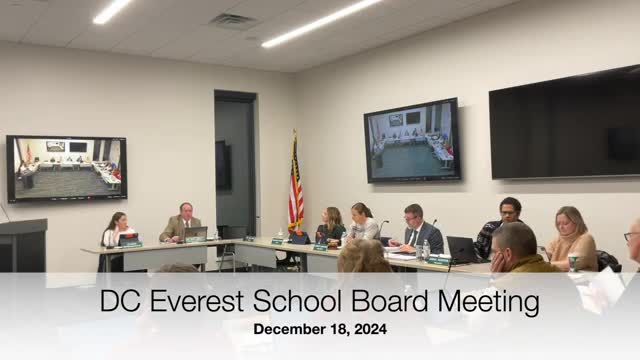Board reviews state report card results, emphasizes local measures and context
January 01, 2025 | D C Everest Area School District, School Districts, Wisconsin
This article was created by AI summarizing key points discussed. AI makes mistakes, so for full details and context, please refer to the video of the full meeting. Please report any errors so we can fix them. Report an error »

Board members reviewed the state report card results and discussed how the district uses multiple local measures to interpret the statewide score.
The administration told the board the district’s state report-card score was 70.8 this year, a decline of two points from the prior year. Dr. Dan (Superintendent) framed the score as a limited summary metric: "The score is the part that's super difficult," he said, adding that the report card is a computer-generated composite that can be hard to unpack but that the underlying measures — achievement, growth, target-group outcomes and on-track-to-graduation metrics — remain important to district planning.
Staff explained why the district watches multiple local measures in addition to the state score. Jeff (Staff member) described frequent assessments the district uses, including FastBridge and aimsWeb, and other tools that measure belonging and student connections. Casey (Staff member) and other speakers urged communicating a broader story to the public beyond the single state score, noting the district’s local accomplishments — such as industry-recognized credentials, apprenticeships, and high participation in dual-enrollment and AP coursework — that the report card does not fully capture.
Administrators pointed to attendance as one important driver of the report-card trend because the state calculation uses a three-year rolling average; the district noted that attendance patterns during the COVID period remain part of that average and could be affecting the current result. The board also discussed assessment transitions (for example, the shift from state forward exams to the ACT suite in high school) that influence comparative scores.
The board asked for and received clarifying details about how the report card is constructed and how the district will continue to use local data to set goals. There was broad agreement that the state score provides a high-level snapshot but that district leaders need to continue using regular, formative measures and targeted interventions to improve student outcomes.
Ending: The board did not take action on the report-card itself but directed staff to continue using local assessments and to communicate more of the district's broader performance context to the community.
The administration told the board the district’s state report-card score was 70.8 this year, a decline of two points from the prior year. Dr. Dan (Superintendent) framed the score as a limited summary metric: "The score is the part that's super difficult," he said, adding that the report card is a computer-generated composite that can be hard to unpack but that the underlying measures — achievement, growth, target-group outcomes and on-track-to-graduation metrics — remain important to district planning.
Staff explained why the district watches multiple local measures in addition to the state score. Jeff (Staff member) described frequent assessments the district uses, including FastBridge and aimsWeb, and other tools that measure belonging and student connections. Casey (Staff member) and other speakers urged communicating a broader story to the public beyond the single state score, noting the district’s local accomplishments — such as industry-recognized credentials, apprenticeships, and high participation in dual-enrollment and AP coursework — that the report card does not fully capture.
Administrators pointed to attendance as one important driver of the report-card trend because the state calculation uses a three-year rolling average; the district noted that attendance patterns during the COVID period remain part of that average and could be affecting the current result. The board also discussed assessment transitions (for example, the shift from state forward exams to the ACT suite in high school) that influence comparative scores.
The board asked for and received clarifying details about how the report card is constructed and how the district will continue to use local data to set goals. There was broad agreement that the state score provides a high-level snapshot but that district leaders need to continue using regular, formative measures and targeted interventions to improve student outcomes.
Ending: The board did not take action on the report-card itself but directed staff to continue using local assessments and to communicate more of the district's broader performance context to the community.
View full meeting
This article is based on a recent meeting—watch the full video and explore the complete transcript for deeper insights into the discussion.
View full meeting
